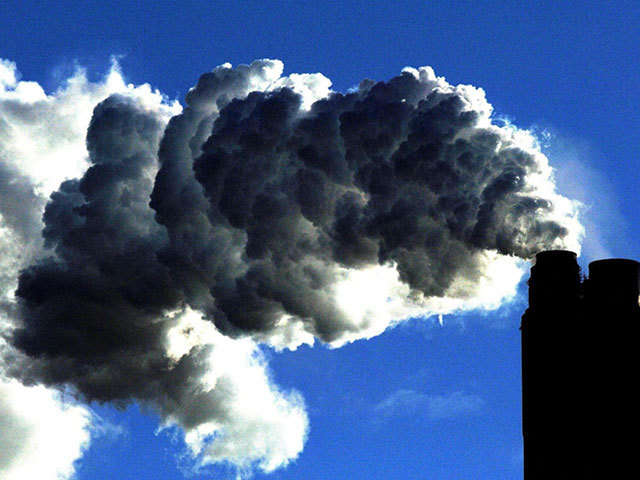
The nation gets its chance this week to blast or praise the Environmental Protection Agency’s sweeping plan to cut climate-warming emissions by 2030.
Companies, environmental advocates and citizens will sound off at EPA hearings starting tomorrow in Atlanta, Denver and Washington about the 645-page proposal, unveiled two months ago, to limit carbon-dioxide emissions from power plants. A two-day hearing in Pittsburgh starts July 31. The agency says more than 1,600 people are scheduled to speak and by last week all slots were filled in Atlanta, Denver and Washington.
About 300,000 comments already have been submitted on the power-plant rule, with weeks to go before the deadline. And 683 businesses and nonprofit groups registered to lobby the EPA this year, more than any other federal department, the Center for Responsive Politics reported.
“This is the main event for climate action in this administration,” Vicki Arroyo, executive director of the Georgetown Climate Center, said in an interview. “EPA actually crafted it to be a very broad approach, and so that brings in a large number of actors.”
Analysts say the plan could cut coal use by almost half, while boosting power generated from natural gas, nuclear plants and renewable energy. Environmental advocates say such a shift is long overdue. Many business lobbyists say the change could cause electricity prices to rise and damage fledgling industries. That fight flared last week in anticipation of this week’s public hearings.
Business groups appealed to EPA Administrator Gina McCarthy to scrap the plan, saying it goes beyond what’s allowed by law and requires fossil-fuel plants to seek reductions from other sources, like getting customers to curb their power demand.
“It is clear that the rule presents a significant threat to American jobs and the economy,” the US Chamber of Commerce, National Association of Manufacturers and dozens of other groups wrote in a letter to McCarthy. “We therefore urge EPA to go back to the drawing board on this rule.”
There’s no sign the agency will start over. McCarthy defended the effort to lawmakers last week, while pledging to consider technical fixes.
Before the proposal was issued, the Chamber released an estimate of the damage the economy, saying the rule’s cost could be $50 billion a year. That estimate was challenged by the EPA because it wasn’t based on any plan from the agency. Now that the proposal is out, the group says it would be too difficult to analyze the actual proposal because the EPA set targets state by state.
“It would require 49 different models,” said Karen Harbert, the head of the Chamber’s energy institute. (Vermont has no fossil-fuel power plants, and so no required reductions.)
About 3,000 coal miners, vendors and coal-town residents say they will rally across the river from the Pittsburgh meeting site, trying to stop a rule they call EPA’s “most devastating yet.”
On the other side, environmental and health groups are organizing hundreds of supporters to testify, and are airing television advertisements in the four cities that call the Chamber’s economic estimate “fiction.”
“This shows that the polluters and their allies are desperate,” Gene Karpinski, president of the League of Conservation Voters, said in a telephone briefing. The EPA plan “is the single biggest step that the government has taken to reduce carbon pollution.”
Karpinski said that more than 4 million people submitted comments on a separate EPA proposal covering new power plants, and said he and his allies also would be rounding up support for the proposal on existing plants. Separately, a radio advertisement from the consumer group Public Citizen will target Murray Energy Corp., the Pepper Pike, Ohio-based coal producer that filed suit to stop the EPA in its tracks.
To be sure, both supporters and critics have their own ideas for changes. Environmental groups want deadlines tightened so emissions are cut sooner, and think states can ramp up use of renewable power and energy efficiency more effectively than the agency had predicted.
It “is a very good and historic start. But it can, and should, set more ambitious carbon-reduction goals,” Ed Chen, a spokesman for the Natural Resources Defense Council, said in an e-mail. The “standards significantly underestimate the carbon- reduction contributions by energy efficiency, solar and wind power as clean replacements for dirty, retiring coal plants.”
Industry groups say EPA’s calculations may inadvertently harm nuclear plants, which emit zero carbon, and in some cases call on shuttered natural-gas plants to replace coal. Also, the EPA both assumes coal plants will be more efficient and run less, which would make them less efficient.
The June 2 proposal from the EPA sets standards for each state based on the carbon from their coal and gas-fired power plants, and then used a formula based on available natural-gas capacity, renewables use and energy use cuts to set state goals for cuts by 2030. Those cuts start to phase in in 2020.
Because emissions from power plants fell about 15% from 2005 through last year, the actual reductions are much smaller. The EPA said it would lead to $90 billion in climate and health benefits, while costing utilities as much as $8.8billion.
And, not every business group opposes the plan. Business Forward, which represents companies such as Cheniere Energy Inc., Ford Motor Co., Google Inc. and Pacific Gas & Electric Co., hosted a call with McCarthy July 24 to rally support for combating climate change.
Inaction on dealing with climate change is an economic threat at the moment, and the plan can be a benefit to the economy, McCarthy told them.
“Businesses are paying the brunt of a changing climate,” McCarthy told the business group. “We can turn these climate risks into real opportunities.”
Recommended for you
